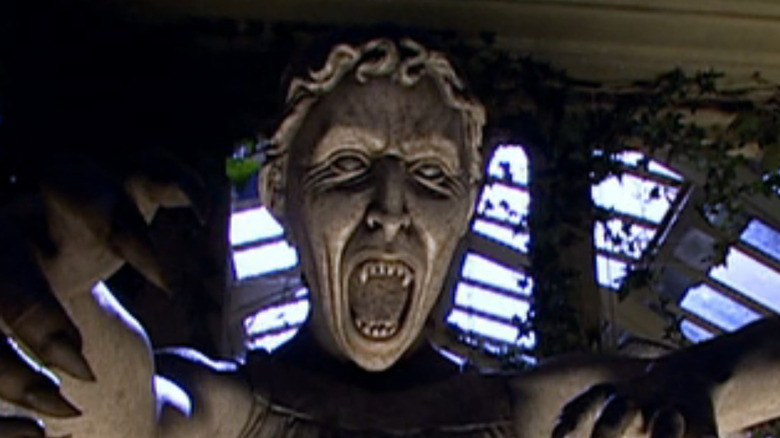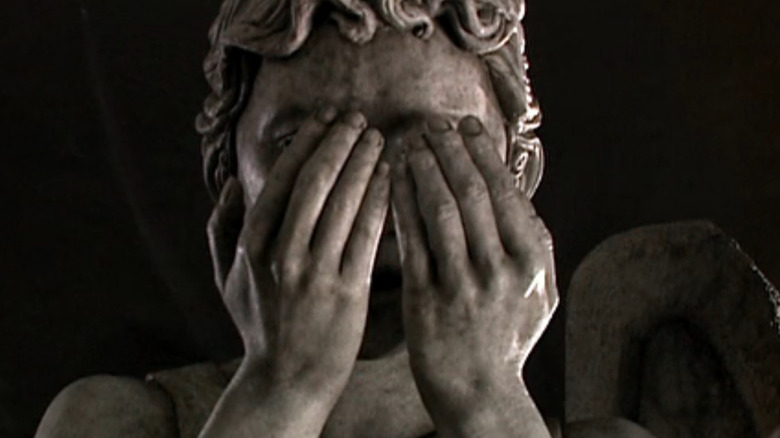What You Never Noticed About Doctor Who's Weeping Angels
Since its debut nearly 60 years ago, the classic British sci-fi adventure show "Doctor Who" has introduced fans to a colorful spectrum of aliens and monsters. From the deadly Daleks to the terrifying Cybermen, few other science-fiction franchises have such a wide array of classic enemies to draw from. We've seen many incarnations of The Doctor take them on over the decades, and in the years since the show was revived in 2005, we've witnessed the introduction of many more.
The Weeping Angels, first introduced during David Tennant's run as the Tenth Doctor in the Season 3 episode "Blink," are often regarded as the scariest monsters in the series. It's considered an all-time great episode, mostly due to the sheer horror of the Angels. They appear to be inanimate statues, but that's only because they're "quantum locked," meaning they can't move while observed. If you stop looking at them, even to blink, they get closer to you. Once they come close enough to touch their victims, they transport people back in time to feed off the time energy generated by the displacement. But if that sounds like light punishment, be warned: Sometimes the Angels will simply kill their prey.
Of course, Weeping Angels wouldn't be half as scary if they didn't look so horrifying. They first appear to victims as stone statues with hands covering their eyes (hence the "weeping" moniker), but each time a victim looks away, the Angels move so quickly that they appear to change poses, reaching out with twisted faces and a mouthful of fangs. The Angels are so realistic, viewers may assume they're looking at actual statues. But if Weeping Angels have taught us anything, it's that looks are deceiving.
The Weeping Angels look like statues but they're actually actors
Despite looking like stone, the Weeping Angels are actually trained actors buried under a boatload of makeup and prosthetics. When "Blink" writer Steven Moffat became the showrunner on "Doctor Who," the movie magic was revealed in much more detail. In a behind-the-scenes look at the Weeping Angels in "Doctor Who: Monster Files," prosthetics supervisor Reza Karim explained that the team had created several prosthetics costumes for Angels in various stages of decay. To make them work, the actors had to fit those proportions. Karim said, "We were casting angels who were a particular size and height, and then what we'd do is we'd get them in for a fitting" (via TheTardisDatabase on YouTube).
The Weeping Angel costume is a series of interlocking parts consisting of a skirt-like bottom half, a toga top, a set of wings, and a mask molded to each actor's face. As Aga Blonska, one of the actors playing an Angel, explained, "It's surprisingly easy to keep still in it. As soon as you put it on, you kind of almost freeze into positions because it's quite a restrictive kind of costume. You don't tend to want to move too much, so you just end up standing still." It sounds like an intense job, and Karim noted that the actors stay in costume for about 10 hours a day during shoots and only the mask comes off between shots. Eleventh Doctor Matt Smith said, "These poor girls have to go through four or five hours of prosthetic makeup," and he noted that they must stand still while not breathing during the shots.
It's a lot of work, but then again, creatures as iconic as the Weeping Angels wouldn't be possible without some serious effort. Karim assures viewers, "They're quite comfortable in that outfit."

